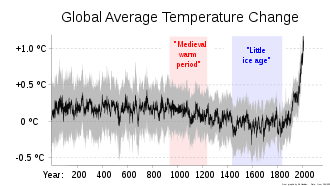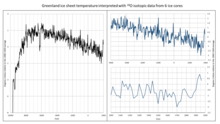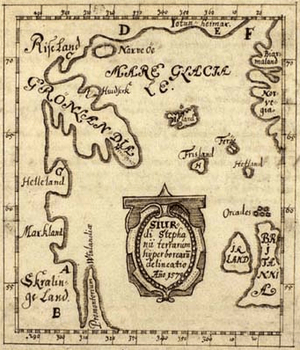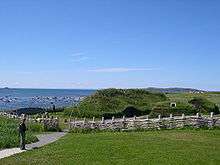Medieval Warm Period
The Medieval Warm Period (MWP) also known as the Medieval Climate Optimum, or Medieval Climatic Anomaly was a time of warm climate in the North Atlantic region lasting from c. 950 to c. 1250.[2] It was likely[3] related to warming elsewhere[4][5][6] while some other regions were colder, such as the tropical Pacific. Average global mean temperatures have been calculated to be similar to early-mid-20th-century warming. Possible causes of the Medieval Warm Period include increased solar activity, decreased volcanic activity, and changes to ocean circulation.[7]

The period was followed by a cooler period in the North Atlantic and elsewhere termed the Little Ice Age. Some refer to the event as the Medieval Climatic Anomaly as this term emphasizes that climatic effects other than temperature were important.[8][9]
It is thought that between c. 950 and c. 1100 was the Northern Hemisphere's warmest period since the Roman Warm Period. It was only in the 20th and 21st centuries that the Northern Hemisphere experienced higher temperatures. Climate proxy records show peak warmth occurred at different times for different regions, indicating that the Medieval Warm Period was not a globally uniform event.[10]
Initial research
The Medieval Warm Period (MWP) is generally thought to have occurred from c. 950–c. 1250, during the European Middle Ages.[2] In 1965 Hubert Lamb, one of the first paleoclimatologists, published research based on data from botany, historical document research and meteorology, combined with records indicating prevailing temperature and rainfall in England around c. 1200 and around c. 1600. He proposed, "Evidence has been accumulating in many fields of investigation pointing to a notably warm climate in many parts of the world, that lasted a few centuries around c. 1000–c. 1200 AD, and was followed by a decline of temperature levels till between c. 1500 and c. 1700 the coldest phase since the last ice age occurred."[11]
The warm period became known as the Medieval Warm Period, and the cold period was called the Little Ice Age (LIA). However, that view was questioned by other researchers; the IPCC First Assessment Report of 1990 discussed the "Medieval Warm Period around 1000 AD (which may not have been global) and the Little Ice Age which ended only in the middle to late nineteenth century." It said temperatures in the "late tenth to early thirteenth centuries (about AD 950-1250) appear to have been exceptionally warm in western Europe, Iceland and Greenland".[12] The IPCC Third Assessment Report from 2001 summarized newer research: "evidence does not support globally synchronous periods of anomalous cold or warmth over this time frame, and the conventional terms of 'Little Ice Age' and 'Medieval Warm Period' appear to have limited utility in describing trends in hemispheric or global mean temperature changes in past centuries."[13] Global temperature records taken from ice cores, tree rings, and lake deposits, have shown that the Earth may have been slightly cooler globally (by 0.03 °C) than in the early and mid-20th century.[14][15]
Palaeoclimatologists developing region-specific climate reconstructions of past centuries conventionally label their coldest interval as "LIA" and their warmest interval as the "MWP."[14][16] Others follow the convention, and when a significant climate event is found in the "LIA" or "MWP" time frames, they associate their events to the period. Some "MWP" events are thus wet events or cold events rather than strictly warm events, particularly in central Antarctica, where climate patterns opposite to the North Atlantic area have been noticed.
Evidence exists across the world, often very sparsely, for changes in climatic conditions over time. Some of the "warm period" events documented below are actually "dry periods" or "wet periods."[17]
Globally
A 2009 study by Michael E. Mann et al., examining spatial patterns of surface temperatures shown in multi-proxy reconstructions finds that the Medieval Warm Period, shows "warmth that matches or exceeds that of the past decade in some regions, but which falls well below recent levels globally."[2] Their reconstruction of the pattern is characterised by warmth over large part of North Atlantic, Southern Greenland, the Eurasian Arctic, and parts of North America which appears to substantially exceed that of the late 20th century (1961–1990) baseline and is comparable or exceeds that of the past decade or two in some regions. Certain regions, such as central Eurasia, northwestern North America, and (with less confidence) parts of the South Atlantic, exhibit anomalous coolness.
Further analysis of the bulk compilation of all paleoclimatology studies that were done in various areas around the globe appear to indicate a global trend of warming, particularly in the northern and southern peaks but less towards the equator.[18] More recently, a study by the Pages-2k consortium suggests the warming was not globally synchronous: "Our regional temperature reconstructions also show little evidence for globally synchronized multi-decadal shifts that would mark well-defined worldwide MWP and LIA intervals. Instead, the specific timing of peak warm and cold intervals varies regionally, with multi-decadal variability resulting in regionally specific temperature departures from an underlying global cooling trend."[19] In direct contrast to these findings, a 2013 study recreates a "temperature record of western equatorial Pacific subsurface and intermediate water masses over the past 10,000 years that shows that heat content varied in step with both northern and southern high-latitude oceans. The findings support the view that the Holocene Thermal Maximum, the Medieval Warm Period, and the Little Ice Age were global events, and they provide a long-term perspective for evaluating the role of ocean heat content in various warming scenarios for the future."[20]
North Atlantic


Lloyd D. Keigwin's 1996 study of radiocarbon-dated box core data from marine sediments in the Sargasso Sea found that its sea surface temperature was approximately 1 °C (1.8 °F) cooler approximately 400 years ago (the Little Ice Age) and 1700 years ago and approximately 1 °C warmer 1000 years ago (the Medieval Warm Period).[21]
Using sediment samples from Puerto Rico, the Gulf Coast, and the Atlantic Coast from Florida to New England, Mann et al. (2009) found consistent evidence of a peak in North Atlantic tropical cyclone activity during the Medieval Warm Period that was followed by a subsequent lull in activity.[22]
By retrieval and isotope analysis of marine cores and from examination of mollusc growth patterns from Iceland, Patterson et al were able to reconstruct a mollusc growth record at a decadal resolution from the Roman Warm Period to the Medieval Warm Period and the Little Ice Age.[23]
North America

The 2009 Mann et al. study found warmth exceeding 1961–1990 levels in Southern Greenland and parts of North America during the Medieval Climate Anomaly (defined in the study from 950 to 1250) with warmth in some regions exceeding temperatures of the 1990–2010 period. Much of the Northern Hemisphere showed significant cooling during the Little Ice Age (defined in the study from 1400 to 1700), but Labrador and isolated parts of the United States appeared to be approximately as warm as during the 1961–1990 period.[2]
Norse colonization of the Americas has been associated with warmer periods. The common theory is that Norsemen took advantage of ice-free seas to colonize areas in Greenland and other outlying lands of the far north.[24] However a study from Columbia University suggests that Greenland was not colonized in warmer weather, but in fact the warming effect was very short term.[25] c. 1000AD, the climate was sufficiently warm for the Vikings to journey to Newfoundland and establish a short-lived outpost there.[26]
From around 985, Vikings founded the Eastern Settlement and Western Settlement, both near the southern tip of Greenland. In the colony's early stages, they kept cattle, sheep, and goats, with around a quarter of their diet from seafood. After the climate became colder and stormier around 1250, their diet steadily shifted towards ocean sources; by around 1300, seal hunting provided over three quarters of their food.
By 1350, there was reduced demand for their exports, and trade with Europe fell away. The last document from the settlements dates from 1412, and over the following decades, the remaining Europeans left in what seems to have been a gradual withdrawal, caused mainly by economic factors such as increased availability of farms in Scandinavian countries.[27]

In Chesapeake Bay (now Maryland and Virginia in the United States), researchers found large temperature excursions (changes from the mean temperature of that time) during the Medieval Warm Period (about 950–1250) and the Little Ice Age (about 1400–1700, with cold periods persisting into the early 20th century), possibly related to changes in the strength of North Atlantic thermohaline circulation.[28] Sediments in Piermont Marsh of the lower Hudson Valley show a dry Medieval Warm period from 800 to 1300.[29]
Prolonged droughts affected many parts of the western United States and especially eastern California and the west of Great Basin.[14][30] Alaska experienced three time intervals of comparable warmth: 1–300, 850–1200, and post-1800.[31] Knowledge of the North American Medieval Warm Period has been useful in dating occupancy periods of certain Native American habitation sites, especially in arid parts of the western United States.[32][33] MWP droughts may have also impacted Native American settlements in the eastern United States, such as at Cahokia.[34][35] Review of more recent archaeological research shows that as the search for signs of unusual cultural changes has broadened, some of the early patterns (for example, violence and health problems) having been found to be more complicated and regionally varied than it had been previously thought. Others, like settlement disruption, deterioration of long distance trade, and population movements, have been further corroborated.[36]
Africa
The climate in equatorial eastern Africa has alternated, being between drier than today and relatively wet. The drier climate took place during the Medieval Warm Period (1000–1270).[37]
Antarctica
A sediment core from the eastern Bransfield Basin, Antarctic Peninsula, preserves climatic events from the Little Ice Age and the Medieval Warm Period. The authors noted, "The late Holocene records clearly identify Neoglacial events of the Little Ice Age (LIA) and Medieval Warm Period (MWP)."[38]
Pacific Ocean
Corals in the tropical Pacific Ocean suggest that relatively cool, dry conditions may have persisted early in the millennium, consistent with a La Niña-like configuration of the El Niño-Southern Oscillation patterns.[39]
South America
The Medieval Warm Period has been noted in Chile in a 1500-year lake bed sediment core[40] as well as in the Eastern Cordillera of Ecuador.[41]
A reconstruction based on ice cores found the Medieval Warm Period could be distinguished in tropical South America from about 1050 to 1300 that was followed, in the 15th century, by the Little Ice Age. Peak temperatures did not rise as high as those from the late 20th century, which were unprecedented in the area during the study period of 1600 years.[42]
Asia
Adhikari and Kumon (2001), investigating sediments in Lake Nakatsuna in central Japan, found a warm period from 900 to 1200 that corresponded to the Medieval Warm Period and three cool phases, two of which could be related to the Little Ice Age.[43] Another research in northeastern Japan shows that there is one warm and humid interval, from 750 to 1200, and two cold and dry intervals, from 1 to 750 and from 1200 to now.[44] Ge et al. studied temperatures in China during the past 2000 years and found high uncertainty prior to the 16th century but good consistency over the last 500 years highlighted by the two cold periods, 1620s–1710s and 1800s–1860s, and the warming during the 20th century. They also found that the warming during the 10–14th centuries in some regions might be comparable in magnitude to the warming of the last few decades of the 20th century, which was unprecedented within the past 500 years.[45]
Oceania
There is an extreme scarcity of data from Australia for both the periods of the Medieval Warm Period and the Little Ice Age. However, evidence from wave-built shingle terraces for a permanently-full Lake Eyre[46] during the 9th and 10th centuries is consistent with a La Niña-like configuration, but the data is insufficient to show how lake levels varied from year to year or what climatic conditions elsewhere in Australia were like.
A 1979 study from the University of Waikato found,"Temperatures derived from an 18O/16O profile through a stalagmite found in a New Zealand cave (40.67°S, 172.43°E) suggested the Medieval Warm Period to have occurred between AD c. 1050 and c. 1400 and to have been 0.75 °C warmer than the Current Warm Period."[47] More evidence in New Zealand is from an 1100-year tree-ring record.[48]
See also
- Cretaceous Thermal Maximum – A period of climatic warming that reached its peak approximately 90 million years ago
- Description of the Medieval Warm Period and Little Ice Age in IPCC reports
- Historical climatology
- Holocene climatic optimum – A warm period during roughly the interval 9,000 to 5,000 years BP
- Hockey stick graph – Graph showing a large spike in recent centuries' temperatures resembling a hockey stick to demonstrate anthropogenic climate change
- Late Antique Little Ice Age
- Paleoclimatology – Study of changes in ancient climate
References
- Hawkins, Ed (January 30, 2020). "2019 years". climate-lab-book.ac.uk. Archived from the original on February 2, 2020. ("The data show that the modern period is very different to what occurred in the past. The often quoted Medieval Warm Period and Little Ice Age are real phenomena, but small compared to the recent changes.")
- Mann, M. E.; Zhang, Z.; Rutherford, S.; et al. (2009). "Global Signatures and Dynamical Origins of the Little Ice Age and Medieval Climate Anomaly" (PDF). Science. 326 (5957): 1256–60. Bibcode:2009Sci...326.1256M. doi:10.1126/science.1177303. PMID 19965474.
- Rosenthal, Y.; Linsley, B. K.; Oppo, D. W. (2013). "Pacific Ocean Heat Content During the Past 10,000 Years". Science. 342 (6158): 617–621. Bibcode:2013Sci...342..617R. doi:10.1126/science.1240837. PMID 24179224.
- Grove, Jean M.; Switsur, Roy (1994). "Glacial geological evidence for the medieval warm period" (PDF). Climatic Change. 26 (2–3): 143. Bibcode:1994ClCh...26..143G. doi:10.1007/BF01092411.
- Diaz, Henry F.; Hughes, M. (1994). The Medieval warm period. Boston: Kluwer Academic Publishers. p. 134. ISBN 978-0-7923-2842-1.
6.2 Evidence for a Medieval Warm Epoch
- Li, H.; Ku, T. (2002). "Little Ice Age and Medieval Warm Periods in Eastern China as Read from the Speleothem Records". AGU Fall Meeting Abstracts. 71: 71C–09. Bibcode:2002AGUFMPP71C..09L.
- "How does the Medieval Warm Period compare to current global temperatures?". SkepticalScience. Retrieved October 12, 2017.
- Bradley, Raymond S. (2003). "Climate of the Last Millennium" (PDF). Climate System Research Center.
- Ladurie, Emmanuel Le Roy (1971). Times of Feast, Times of Famine: a History of Climate Since the Year 1000. Farrar Straus & Giroux. ISBN 978-0-374-52122-6.
- Solomon, Susan Snell; Intergovernmental Panel on Climate Change (2007). "6.6 The Last 2,000 Years". Climate change 2007: the physical science basis: contribution of Working Group I to the Fourth Assessment Report of the Intergovernmental Panel on Climate Change. Cambridge: Cambridge University Press for the Intergovernmental Panel on Climate Change. ISBN 978-0-521-70596-7.CS1 maint: multiple names: authors list (link) Box 6.4
- Lamb, H.H. (1965). "The early medieval warm epoch and its sequel". Palaeogeography, Palaeoclimatology, Palaeoecology. 1: 13–37. Bibcode:1965PPP.....1...13L. doi:10.1016/0031-0182(65)90004-0.
- IPCC First Assessment Report Working Group 1 report, Chapter 7, Executive Summary p. 199, Climate Of The Past 5,000,000 Years p.202.
- Folland, C.K.; Karl, T.R.; Christy, J.R.; et al. (2001). "2.3.3 Was there a "Little Ice Age" and a "Medieval Warm Period"?"". In Houghton, J.T.; Ding, Y.; Griggs, D.J.; Noguer, M.; van der Linden; Dai; Maskell; Johnson (eds.). Working Group I: The Scientific Basis. Intergovernmental Panel on Climate Change Climate Change 2001. Cambridge, United Kingdom and New York, NY, USA: Cambridge University Press. p. 881. ISBN 978-0-521-80767-8.
- Bradley, R. S.; Hughes, MK; Diaz, HF (2003). "CLIMATE CHANGE: Climate in Medieval Time". Science. 302 (5644): 404–5. doi:10.1126/science.1090372. PMID 14563996.
- Crowley, Thomas J.; Lowery, Thomas S. (2000). "How Warm Was the Medieval Warm Period?". AMBIO: A Journal of the Human Environment. 29: 51–54. doi:10.1579/0044-7447-29.1.51.
- Jones, P. D.; Mann, M. E. (2004). "Climate over past millennia". Reviews of Geophysics. 42 (2): 2002. Bibcode:2004RvGeo..42.2002J. doi:10.1029/2003RG000143.
- Mann, Michael E. (May 2010). "What we can learn from studying the last millennium (or so)". RealClimate.
- "Medieval Warm Period - Google My Maps". Google My Maps. Retrieved 7 April 2018.
- https://www.blogs.uni-mainz.de/fb09climatology/files/2012/03/Pages_2013_NatureGeo.pdf
- Rosenthal, Y.; Linsley, B. K.; Oppo, D. W. (2013). "Pacific Ocean Heat Content During the Past 10,000 Years". Science. 342 (6158): 617–621. Bibcode:2013Sci...342..617R. doi:10.1126/science.1240837. PMID 24179224.
- Keigwin, L. D. (1996). "The Little Ice Age and Medieval Warm Period in the Sargasso Sea". Science. 274 (5292): 1504–1508. Bibcode:1996Sci...274.1504K. doi:10.1126/science.274.5292.1504. PMID 8929406.
- Mann, Michael E.; Woodruff, Jonathan D.; Donnelly, Jeffrey P.; Zhang, Zhihua (2009). "Atlantic hurricanes and climate over the past 1,500 years". Nature. 460 (7257): 880–3. Bibcode:2009Natur.460..880M. doi:10.1038/nature08219. hdl:1912/3165. PMID 19675650.
- Patterson, W. P.; Dietrich, K. A.; Holmden, C.; Andrews, J. T. (2010). "Two millennia of North Atlantic seasonality and implications for Norse colonies". Proceedings of the National Academy of Sciences. 107 (12): 5306–10. Bibcode:2010PNAS..107.5306P. doi:10.1073/pnas.0902522107. PMC 2851789. PMID 20212157.
- Diamond, Jared (2005). Collapse: How Societies Choose to Fail or Succeed. New York: Penguin Books. ISBN 978-0-14-303655-5.
- "Study Undercuts Idea That 'Medieval Warm Period' Was Global - The Earth Institute - Columbia University". www.earth.columbia.edu. Retrieved 7 April 2018.
- Ingstad, Anne Stine (2001). "The Excavation of a Norse Settlement at L'Anse aux Meadows, Newfoundland". In Helge Ingstad; Anne Stine Ingstad (eds.). The Viking Discovery of America. New York: Checkmark. pp. 141–169. ISBN 978-0-8160-4716-1. OCLC 46683692.
- Stockinger, Günther (10 January 2012). "Archaeologists Uncover Clues to Why Vikings Abandoned Greenland". Der Spiegel Online. Retrieved 12 January 2013.
- "Medieval Warm Period, Little Ice Age and 20th Century Temperature Variability from Chesapeake Bay". USGS. Archived from the original on 2006-06-30. Retrieved 2006-05-04.
- "Marshes Tell Story Of Medieval Drought, Little Ice Age, And European Settlers Near New York City". Earth Observatory News. May 19, 2005. Archived from the original on October 2, 2006. Retrieved 2006-05-04.
- Stine, Scott (1994). "Extreme and persistent drought in California and Patagonia during mediaeval time". Nature. 369 (6481): 546–549. Bibcode:1994Natur.369..546S. doi:10.1038/369546a0.
- Hu, F. S. (2001). "Pronounced climatic variations in Alaska during the last two millennia". Proceedings of the National Academy of Sciences. 98 (19): 10552–10556. Bibcode:2001PNAS...9810552H. doi:10.1073/pnas.181333798. PMC 58503. PMID 11517320.
- Dean, Jeffrey S. (1994). "The medieval warm period on the southern Colorado Plateau". Climatic Change. 26 (2–3): 225–241. Bibcode:1994ClCh...26..225D. doi:10.1007/BF01092416.
- C. Michael Hogan (2008) Los Osos Back Bay, Megalithic Portal, editor A. Burnham.
- Benson, Larry V.; Pauketat, Timothy R.; Cook, Edward R. (2009). "Cahokia's Boom and Bust in the Context of Climate Change". American Antiquity. 74 (3): 467–483. doi:10.1017/S000273160004871X. ISSN 0002-7316.
- White, A. J.; Stevens, Lora R.; Lorenzi, Varenka; Munoz, Samuel E.; Schroeder, Sissel; Cao, Angelica; Bogdanovich, Taylor (2019-03-19). "Fecal stanols show simultaneous flooding and seasonal precipitation change correlate with Cahokia's population decline". Proceedings of the National Academy of Sciences. 116 (12): 5461–5466. doi:10.1073/pnas.1809400116. ISSN 0027-8424. PMC 6431169. PMID 30804191.
- Jones, Terry L.; Schwitalla, Al (2008). "Archaeological perspectives on the effects of medieval drought in prehistoric California". Quaternary International. 188 (1): 41–58. Bibcode:2008QuInt.188...41J. doi:10.1016/j.quaint.2007.07.007.
- "Drought In West Linked To Warmer Temperatures". Earth Observatory News. 2004-10-07. Archived from the original on 2006-10-04. Retrieved 2006-05-04.
- Khim, B.; Yoon, Ho Il; Kang, Cheon Yun; Bahk, Jang Jun (2002). "Unstable Climate Oscillations during the Late Holocene in the Eastern Bransfield Basin, Antarctic Peninsula". Quaternary Research. 58 (3): 234. Bibcode:2002QuRes..58..234K. doi:10.1006/qres.2002.2371.
- Cobb, Kim M.; Chris Charles; Hai Cheng; R. Lawrence Edwards (July 8, 2003). "The Medieval Cool Period And The Little Warm Age In The Central Tropical Pacific? Fossil Coral Climate Records Of The Last Millennium". The Climate of the Holocene (ICCI) 2003. Archived from the original on August 25, 2004. Retrieved 2006-05-04.
- Fletcher, M-S.; Moreno, P.I. (16 July 2012). "Vegetation, climate and fire regime changes in the Andean region of southern Chile (38°S) covaried with centennial-scale climate anomalies in the tropical Pacific over the last 1500 years". Quaternary Science Reviews. 46: 46–56. Bibcode:2012QSRv...46...46F. doi:10.1016/j.quascirev.2012.04.016.
- Ledru, M.-P.; Jomelli, V.; Samaniego, P.; Vuille, M.; Hidalgo, S.; Herrera, M.; Ceron, C. (2013). "The Medieval Climate Anomaly and the Little Ice Age in the eastern Ecuadorian Andes". Climate of the Past. 9 (1): 307–321. Bibcode:2013CliPa...9..307L. doi:10.5194/cp-9-307-2013.
- Kellerhals, T.; Brütsch, S.; Sigl, M.; Knüsel, S.; Gäggeler, H. W.; Schwikowski, M. (2010). "Ammonium concentration in ice cores: A new proxy for regional temperature reconstruction?". Journal of Geophysical Research. 115 (D16): D16123. Bibcode:2010JGRD..11516123K. doi:10.1029/2009JD012603.
- Adhikari, D. P.; Kumon, F. (2001). "Climatic changes during the past 1300 years as deduced from the sediments of Lake Nakatsuna, central Japan". Limnology. 2 (3): 157. doi:10.1007/s10201-001-8031-7.
- Yamada, Kazuyoshi; Kamite, Masaki; Saito-Kato, Megumi; Okuno, Mitsuru; Shinozuka, Yoshitsugu; Yasuda, Yoshinori (2010). "Late Holocene monsoonal-climate change inferred from Lakes Ni-no-Megata and San-no-Megata, northeastern Japan". Quaternary International. 220 (1–2): 122–132. Bibcode:2010QuInt.220..122Y. doi:10.1016/j.quaint.2009.09.006.
- Ge, Q.-S.; Zheng, J.-Y.; Hao, Z.-X.; Shao, X.-M.; Wang, Wei-Chyung; Luterbacher, Juerg (2010). "Temperature variation through 2000 years in China: An uncertainty analysis of reconstruction and regional difference". Geophysical Research Letters. 37 (3): 03703. Bibcode:2010GeoRL..37.3703G. doi:10.1029/2009GL041281.
- Allen, Robert J. (1985). The Australasian Summer Monsoon, Teleconnections, and Flooding in the Lake Eyre Basin. Royal Geographical Society of Australasia, S.A. Branch. ISBN 978-0-909112-09-7.
- Wilson, A. T.; Hendy, C. H.; Reynolds, C. P. (1979). "Short-term climate change and New Zealand temperatures during the last millennium". Nature. 279 (5711): 315. Bibcode:1979Natur.279..315W. doi:10.1038/279315a0.
- Cook, Edward R.; Palmer, Jonathan G.; d'Arrigo, Rosanne D. (2002). "Evidence for a 'Medieval Warm Period' in a 1,100 year tree-ring reconstruction of past austral summer temperatures in New Zealand". Geophysical Research Letters. 29 (14): 12. Bibcode:2002GeoRL..29.1667C. doi:10.1029/2001GL014580.
Further reading
- Hughes, Malcolm K.; Diaz, Henry F. (1994). "Was there a 'medieval warm period', and if so, where and when?" (PDF). Climatic Change. 26 (2–3): 109–42. Bibcode:1994ClCh...26..109H. doi:10.1007/BF01092410.
- Fagan, Brian (2000). The Little Ice Age: How Climate Made History, 1300–1850. Basic Books. ISBN 978-0-465-02272-4.
- Fagan, Brian (2009). The Great Warming: Climate Change and the Rise and Fall of Civilizations. Bloomsbury Publishing.
- Lamb, Hubert (1995). Climate, History, and the Modern World: Second Edition. Routledge.
- Vinther, B.M.; Jones, P.D.; Briffa, K.R.; Clausen, H.B.; Andersen, K.K.; Dahl-Jensen, D.; Johnsen, S.J. (2010). "Climatic signals in multiple highly resolved stable isotope records from Greenland". Quaternary Science Reviews. 29 (3–4): 522–38. Bibcode:2010QSRv...29..522V. doi:10.1016/j.quascirev.2009.11.002.
- Staff members at NOAA Paleoclimatology (19 May 2000). The "Medieval Warm Period". A Paleo Perspective...on Global Warming. NOAA Paleoclimatology.
External links
| Wikimedia Commons has media related to Medieval Warm Period. |
- HistoricalClimatology.com, further links, resources, and relevant news, updated 2016
- Climate History Network
- The Little Ice Age and Medieval Warm Period at American Geophysical Union